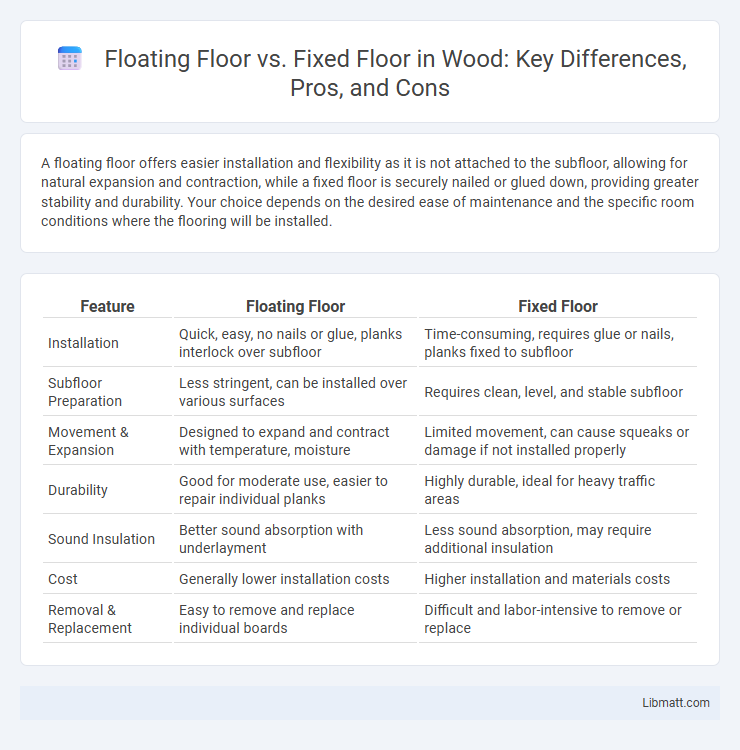A floating floor offers easier installation and flexibility as it is not attached to the subfloor, allowing for natural expansion and contraction, while a fixed floor is securely nailed or glued down, providing greater stability and durability. Your choice depends on the desired ease of maintenance and the specific room conditions where the flooring will be installed.
Table of Comparison
| Feature | Floating Floor | Fixed Floor |
|---|---|---|
| Installation | Quick, easy, no nails or glue, planks interlock over subfloor | Time-consuming, requires glue or nails, planks fixed to subfloor |
| Subfloor Preparation | Less stringent, can be installed over various surfaces | Requires clean, level, and stable subfloor |
| Movement & Expansion | Designed to expand and contract with temperature, moisture | Limited movement, can cause squeaks or damage if not installed properly |
| Durability | Good for moderate use, easier to repair individual planks | Highly durable, ideal for heavy traffic areas |
| Sound Insulation | Better sound absorption with underlayment | Less sound absorption, may require additional insulation |
| Cost | Generally lower installation costs | Higher installation and materials costs |
| Removal & Replacement | Easy to remove and replace individual boards | Difficult and labor-intensive to remove or replace |
Introduction to Floating and Fixed Floors
Floating floors consist of interlocking panels that rest above the subfloor without being nailed or glued, offering easy installation and flexibility. Fixed floors are securely attached to the subfloor using nails, glue, or screws, providing enhanced stability and durability. You can choose between these flooring types based on your need for installation speed, sound insulation, and long-term performance.
Key Differences Between Floating and Fixed Floors
Floating floors are installed without being directly attached to the subfloor, allowing for natural expansion and contraction, while fixed floors are securely fastened to the subfloor, providing a more stable and rigid surface. Floating floors typically use interlocking planks or tiles that rest on underlayment, which offers sound insulation and moisture resistance, whereas fixed floors are nailed or glued down, creating a durable bond ideal for high-traffic areas. The key differences also include installation time and flexibility, with floating floors offering easier DIY installation and potential for reuse, while fixed floors require professional installation and are generally permanent.
Advantages of Floating Floor Installation
Floating floor installation offers enhanced flexibility by allowing the floor to expand and contract with temperature and humidity changes, reducing the risk of warping and damage. This method facilitates quicker and easier installation, as it does not require adhesives or nails, making it ideal for DIY projects and reducing labor costs. Additionally, floating floors provide improved sound insulation and floor comfort through the use of underlayment materials, enhancing the overall living experience.
Advantages of Fixed Floor Installation
Fixed floor installation offers superior stability and durability, making it ideal for heavy foot traffic areas and long-term use. This method provides a solid, immovable foundation that reduces noise transmission and enhances the overall structural integrity of the building. Fixed floors also allow for better integration with underfloor heating systems, improving energy efficiency and comfort.
Common Materials Used in Floating vs Fixed Floors
Floating floors commonly use engineered hardwood, laminate, luxury vinyl planks, and interlocking tiles due to their ease of installation and ability to expand and contract. Fixed floors typically employ solid hardwood, ceramic or porcelain tiles, and natural stone, which require adhesives or nails for a permanent bond to subfloors. The material choice influences installation complexity, durability, and maintenance, with floating floors offering more flexibility and fixed floors providing a sturdier, long-lasting surface.
Installation Process Comparison
Floating floors are installed by interlocking planks or tiles that rest on an underlayment without being glued or nailed, allowing for easy DIY installation and floor movement accommodation. Fixed floors require securing directly to the subfloor through glue, nails, or staples, demanding more preparation and professional installation to ensure stability and durability. The floating floor installation process is generally faster and less invasive, while fixed floors provide a more permanent and solid foundation.
Durability and Maintenance Considerations
Floating floors offer enhanced durability by allowing natural expansion and contraction without damage, reducing the risk of warping and buckling over time. Maintenance of floating floors is generally easier due to their ability to tolerate minor subfloor irregularities and moisture, minimizing costly repairs. Fixed floors, while stable, are more susceptible to cracking and require more vigilant upkeep to address potential structural shifts and water exposure.
Cost Analysis: Floating vs Fixed Floors
Floating floors typically offer a lower installation cost compared to fixed floors due to simpler methods that require less adhesive and subfloor preparation. Fixed floors incur higher upfront expenses related to materials like mortar and prolonged labor efforts to ensure a permanent, secure bond. Your choice between floating and fixed flooring should consider these cost differences alongside long-term durability and maintenance requirements.
Ideal Applications for Each Flooring Type
Floating floors are ideal for DIY installations, rental properties, and areas prone to moisture because they allow for easy expansion and contraction without damage. Fixed floors, securely adhered to the subfloor, are best suited for high-traffic commercial spaces and rooms requiring maximum stability, such as kitchens and bathrooms. Selecting between floating and fixed flooring depends on factors like subfloor condition, installation complexity, and long-term durability needs.
Choosing the Right Floor for Your Space
Selecting between a floating floor and a fixed floor depends on factors such as installation ease, subfloor condition, and room usage. Floating floors offer flexibility and ease of replacement, ideal for areas with potential moisture or shifting subfloors, while fixed floors provide durability and stability suited for high-traffic or heavy-load spaces. Consider the specific requirements of your space, including sound insulation, thermal expansion, and maintenance preferences, to make an informed flooring choice.
Floating floor vs Fixed floor Infographic

 libmatt.com
libmatt.com